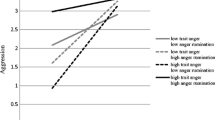Abstract
This study examined the relationship between subject characteristics of aggressive boys and their behavioral changes during a school year. Seventy-six boys in the fourth, fifth, and sixth grades were identified by their teachers as the most disruptive and aggressive in their classes. These boys were assigned to untreated control, anger-coping, anger-coping plus goal-setting treatment, and minimal treatment goal-setting cells. The anger-coping treatment was based on cognitive behavioral procedures. In both anger-coping cells, greater reductions in rates of disruptive/aggressive off-task classroom behavior was predicted by having higher rates of these behaviors initially, and greater reductions in parents' ratings of aggression was predicted by having poor social problem-solving skills initially. Additional predictors of reductions in parents' ratings of aggression in one, but not both, anger-coping cells included having higher rates of somatic symptoms and poorer social acceptance by peers. In contrast to the other cells, those boys in the no-treatment group who demonstrated the greatest spontaneous improvement on these change measures were the ones who initially were the best problem-solvers and who had higher levels of self-esteem. This cognitive-behavioral treatment appeared to have most impact with those boys who were the most in need of intervention.
Similar content being viewed by others
References
Allen, C. J., Chinsky, J. M., Larcen, S. W., Lochman, J. E., & Selinger, H. V. (1976).Community psychology and the schools: A behaviorally oriented multilevel preventive approach. New York: Wiley.
Bergin, A. E. (1971). The evaluation of therapeutic outcomes. In A. E. Bergin & S. L. Garfield (Eds.),Handbook of psychotherapy and behavior change: An empirical analysis (pp. 217–270). New York: Wiley.
Breyer, N. L., & Calchera, D. J. (1971). A behavioral observation schedule for pupils and teachers.Psychology in the Schools, 8, 330–337.
Coopersmith, S. (1967).Antecedents of self-esteem. San Francisco: Freeman.
Copeland, A. P. (1981). The relevance of subject variables in cognitive self-instructional programs for impulsive children.Behavior Therapy, 12, 520–529.
Copeland, A. P., & Hammel, R. (1981). Subject variables in cognitive self-instructional training.Cognitive Therapy and Research, 5, 405–420.
Curry, J. F., & Thompson, R. J., Jr. (1979). The utility of behavior checklist ratings in differentiating developmentally disabled from psychiatrically referred children.Journal of Pediatric Psychology, 4, 345–352.
Deluty, R. H. (1981a). Adaptiveness of aggressive, assertive and submissive behavior for children.Journal of Clinical Child Psychology, 10, 155–158.
Deluty, R. H. (1981b). Alternative-thinking ability of aggressive, assertive, and submissive children.Cognitive Therapy and Research, 5, 309–312.
Forman, S. G. (1980). A comparison of cognitive training and response cost procedures in modifying aggressive behavior of elementary school children.Behavior Therapy, 11, 594–600.
Hobbs, S. A., Moguin, L. E., Tyroler, M., & Lahey, B. B. (1980). Cognitive behavior therapy with children: Has clinical utility been demonstrated?Psychological Bulletin, 87, 147–165.
Kendall, P. C., & Braswell, L. (1982). Cognitive-behavioral self-control therapy for children: A components analysis.Journal of Consulting and Clinical Psychology, 50, 672–689.
Kendall, P. C., & Wilcox, L. E. (1980). Cognitive-behavioral treatment for impulsivity: Concrete versus conceptual training in non-self-controlled problem children.Journal of Consulting and Clinical Psychology, 48, 80–91.
Kendall, P. C., & Zupan, B. A. (1981). Individual versus group application of cognitive-behavioral self-control procedures with children.Behavior Therapy, 12, 344–359.
Kettlewell, P. W., & Kausch, D. F. (1983). The generalization of the effects of a cognitive-behavioral treatment program for aggressive children.Journal of Abnormal Child Psychology, 11, 101–114.
Lochman, J. E., Burch, P. R. Curry, J. F., & Lampron, L. B. (1984). Treatment and generalization effects of cognitive behavioral and goal setting interventions with aggressive boys.Journal of Consulting and Clinical Psychology, 52, 915–916.
Lochman, J. E., Nelson, W. M., III, & Sims, J. P. (1981). A cognitive behavioral program for use with aggressive children.Journal of Clinical Child Psychology, 10, 146–148.
McClure, L. F., Chinsky, J. M., & Larcen, S. W. (1978). Enhancing social problem solving performance in an elementary school setting.Journal of Educational Psychology, 70, 504–513.
Richard, B. A., & Dodge, K. A. (1982). Social maladjustment and problem solving in schoolaged children.Journal of Consulting and Clinical Psychology, 50, 226–233.
Rucker, C. N. (1967).Acceptance of mentally retarded junior high children in academic and non-academic classes. Unpublished doctoral dissertation, University of Iowa.
Sines, J. O., Pauker, J. D., Sines, L. K., & Owen, D. R. (1969). Identification of clinically relevant dimensions of children's behavior.Journal of Consulting and Clinical Psychology, 33, 728–734.
Spivack, G., & Shure, M. (1974).Social adjustment of young children. San Francisco: Jossey-Bass.
Author information
Authors and Affiliations
Additional information
Portions of this paper were presented at the American Psychological Association annual convention, Anaheim, California, August 1983. Acknowledgment is made of the administrative and/or financial support provided by the Durham County School System, the Duke University Medical Center Department of Psychiatry, and the Durham Community Guidance Clinic. Appreciation is expressed to the other coleaders of the groups: Rosalyn Alexander, Steve Harris, Pat Kirkley, Val McLean, Kathy McSwain, Connie Scott, Barbara Thornton, Mary Ann Black, Harvey Botman, Dr. Bonnie Gregory, and Dr. Renee Schoenfeld.
Rights and permissions
About this article
Cite this article
Lochman, J.E., Lampron, L.B., Burch, P.R. et al. Client characteristics associated with behavior change for treated and untreated aggressive boys. J Abnorm Child Psychol 13, 527–538 (1985). https://doi.org/10.1007/BF00923139
Revised:
Issue Date:
DOI: https://doi.org/10.1007/BF00923139




